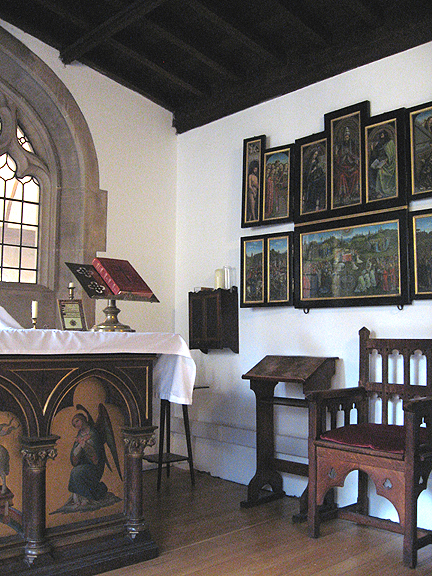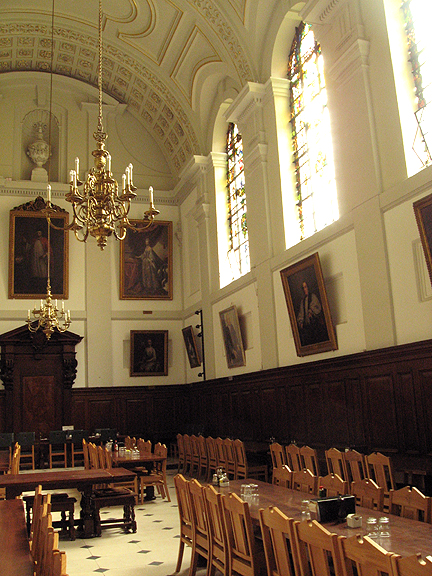
“Towery city, branchy between towers;
Cuckoo-echoing, bell-swarm’d,
lark charm’d, rook racked, river rounded..."
~ Gerard Manley Hopkins, Duns Scotus’s Oxford.
Among the many great gifts that coincided with my fellowship and residency at Oxford was the experience of place. Although my residence was The Kilns, and the primary purpose was to study all things C. S. Lewis, I also found myself immersed in one of the world’s great learning environments. Being amidst such depths of philology and library collections was an inspiration in itself. But the resources are for the living and thinking to tap into, just as the lanes, parks, and corridors are meant to be walked. My residency permitted for a full spectrum of study, discussion, writing, and miles of reflective strolling. I found Oxford to be an ideal place to live the love of learning. Now, the love of learning came rather late for me; as a child, I was one of those pupils that wished to be anywhere other than at those penitentiary-like public schools I had to endure in New York City. Education became more of a pursuit in college, and then more of a passion in graduate school and beyond. When I could choose my own areas of study, the learning ceased to be a drive for grades, and rather a direct means of personal development. Very much like my relationship to writing. Learning and writing have evolved into an intertwined tandem.
blackfriars college



“Let the wise listen and add to their learning, and let the discerning acquire guidance,” wrote King Solomon, in the opening paragraphs of his Proverbs. As my writing adventures had brought me to Oxford, my reading appetite drew me to libraries and through the gates of Blackfriars College. At this particular college, the church- a large one- is at the forefront of the campus, along Saint Giles Street. Reflecting the traditions of the Dominican Order, the church and college share a spartan style of architecture. Unusual for Oxford, ornamentation is sparing, yet the place is beautifully plain. And being a teaching order, the friars have placed their library, as well as an additional chapel, at the heart of the college building.



Among the Dominican friars in residence is the well-travelled author Timothy Radcliffe, who once wrote, “One of our deepest needs is to be at home. We need a place in which we may flourish and be ourselves.” This particular homily concludes with his emphasis that “God wishes to gather us from exile into our home.” The plainness and openness of Blackfriars does evoke the impression of a communal home, and I was able to experience gatherings in their sanctuaries, community spaces, classrooms, and the library.

Above: Library
Below: Classroom


Within the quiet spaces, I was able to gather some words of my own, between readings and visits. The Dominicans’ bookcases were as hedgerows around the room, which reminded me of an intimate and verdant garden. When my written words lose their sense of direction, there are wellsprings of ancient words that hold firm and hold forth in their ready volumes. My notes attest to how I’ve learned that along this voyage, my appreciation for the integral aspects of studying to writing has deepened. Even upon the momentum of calloused pilgrim soles, writing dryness indicates there isn’t enough reading and listening. By listening, I also refer to observing- as can be enjoyed on long walks and in art museums.
queen’s college


To advance and develop in mind and spirit, I’ve found it essential to continue pursuing knowledge and learning. Exploration attests to how much more can be explored. Across town eastward from Blackfriars, along the High Street, is Queen’s College. My first time walking the cloister around the college’s courtyard lawn, Wycliffe came to mind, and I marveled at the prospect of matching my footsteps with his, albeit beneath layers of centuries. John Wycliffe thought and wrote much about divine grace, emphasizing that our good works are indications of the Spirit within, originating from beyond us. As my studies and sponsorship emphasized the life and works of Lewis, these opportunities broadened to spectra I could just simply begin exploring. Indeed, studying one topic easily expands into further topics, finding additional interests- sometimes historically connected, or sufficiently connected by the inquiring scholar.

Above: Dining Room
Below: Chapel, with Lectionary Bible

On one occasion, I walked into the Queen’s College chapel, and noticed visitors reading to one another from the large lector’s Bible at the center of the sanctuary. There wasn’t a service in progress. People were simply and casually reading and listening in turn. I read, as well, noticing the acoustic of the space which allowed me to slow and mute my tones. The most enduring proclamations are the gentlest. In this spontaneity of brief oration and lengthened listening, I further saw how spans of time in such places of learning naturally lean toward gathering. My years of intense employment have cultivated a hungered drive for constant productivity. But this learning experience caused me to be immersed, rather than to think too much about projects. The pendulum, however, continues to move between absorption and practice, between note-taking and structured writing. Knowledge is often patient, and so must be its gathering; though far from passive, study is an entirely active pursuit.

instruments and arts

Ashmolean Museum, Oxford

My gratitude for occasions of exploration and instruction found still more inspiration at Oxford’s Ashmolean Museum. The stately edifice presents both permanent collections and rotating exhibits in modernized galleries. Among the levels of installations, perhaps owing to the context of my visits, I was most intrigued by the interpretive displays that show how things are made. I suppose the incurable practitioner relishes technique alongside result. With the Ashmolean’s exhibitions of prints and icons, are narrative displays of the corresponding scribal tools for these manual arts.

Exhibits describing the processes of:
Above: Iconography
Below: Manuscript Illumination
and Intaglio Printmaking (etching).


Amidst intellectual and spiritual speculation is the desire for application. “Lift up your soul,” wrote Richard Baxter, in his essay The Divine Life (17th c), and “oft take occasion from what you see, or hear, or do, for more meditation or discourse.” “A lively spiritual knowledge,” added Baxter, “actuates grace.” Becoming more aware of the gentle pendulum between studying and writing, I also found myself learning about learning processes themselves!
scriptum


From libraries, oratories, and exhibits, my steps returned to my favorite Oxford shop, Scriptum. Stopping in to this- and shops like it- for various odds and ends that helped equip me during my month at Oxford, I saved my last Scriptum errand for their custom-made journal books. The shop’s arrays of quills, inks, and stationery complemented my appreciation for the enduring written words on my immersions in the Bodleian reading rooms. The soaring thoughts of minds such as Eriugena, Wycliffe, and Erasmus, were penned with sharpened feathers. The reams and reams of manuscripts I read among the archives of C. S. Lewis were written by dip pen and his portable Royal typewriter. And across centuries, millennia, and countless writers, words reach our hands and eyes illuminated by this day. The consideration of heritages of written expression must not overwhelm, but rather must inspire continuity. As the far continuum of authors comprises those who could not have predicted their influence, it is not for us to know the full extent of rings resultant from our castings upon the waters.





As fellow pilgrims of the written word, I thoroughly enjoyed my chats with the different members of the Scriptum staff. We compared notes about writing materials, travels, and the places we come from. I’m grateful that I can keep myself in their notebooks, by mail, and that we can keep in contact. Inevitably, cultivating learning and writing transcends place and time. Our adventures are chapters in the books we carry with our steps and souls. As we choose to draw upon sojourns near and far, the places of our inspiration are indeed never far from our selves.

Above: Scriptum Oxford journals
Below: Saint Mary's Church (University Church), Oxford.

































